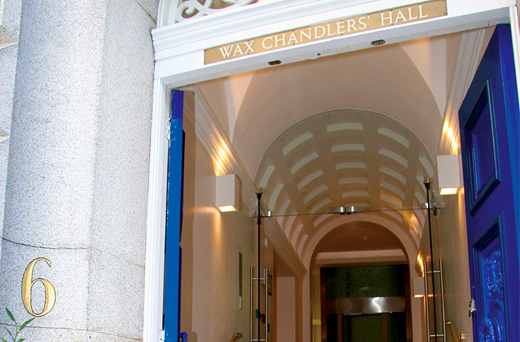The Company was granted Arms on 3 February 1485 by Clarenceaux King-of-Arms. The Shield, ‘Azure upon a chevron argent three roses gules seeded or between three royal mortars gold’. The three mortars represent a form of candlestick used at funerals and rites in remembrance of the dead (a major source of business to the pre-Reformation Wax Chandler). The red (gules) rose is a flower particularly associated with the Virgin Mary, as are the colours blue (azure), gold (or) and silver (argent).
The crest, ‘Upon a wreath of flowers a maiden in a courcoat of cloth of gold lined/furred with ermine kneeling among divers flowers proper making in her hand a garland of the same flowers Mantelled azure double ermine’ is probably a reference to the ‘garden inclosed’, a symbol of purity. (Song of Solomon 4.12). A later version of the crest describes the maiden kneeling in a rosebush, or ‘roseayre’. The cult of Our Lady of the Rosary flourished from c1460. The maiden is most unlikely to be the Virgin Mary herself, since she is not represented in the traditional way.
In 1530, the Company was granted supporters for its Arms – unicorns argent gorged with a garland of various flowers proper, the horn wreathed or and gules. The unicorn is another symbol of purity. According to one legend, which is also an allegory of the Annunciation of the Virgin Mary, a unicorn can only be trapped by setting a virgin in its haunts, whereupon it will lay its head in her lap and sleep. The Company’s motto, Truth is the Light, was granted to the Company in 1634
The acquisition of a coat of arms by a Livery Company signified social status in the same way that a coat of arms was the badge of a gentleman: a visual affirmation of its permanence and distinguished heritage: a combination of a traditionally noble characteristic with merchants and craftsmen. The care and expense that Livery Companies lavished on the acquisition, preservation and display of their important documents and insignia suggest that antiquity and heraldry were important aspects of their sense of corporate identity, alongside processions, halls, feasts and clothing. It is interesting to note that, as more attributes of status were added to its heraldry, the Wax Chandlers chose to have these painted, or written onto, the original Grant rather than acquire a new document.
Although it has been claimed that the heraldry was intended to carefully distinguish a company from its peers, the general outline of the Company’s shield is common to a number of other Livery Companies. The Weavers, Plaisterers and Pewterers all have a blue background and symbols (roses, fleurs de lys) associated with the Virgin Mary on a silver chevron.


